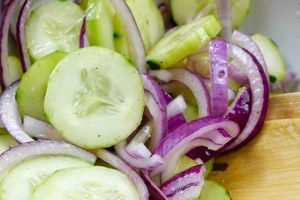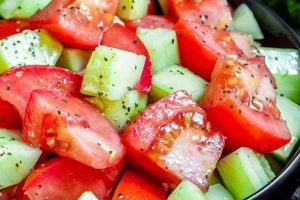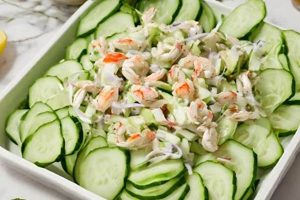A refreshing and simple dish, typically composed of sliced cucumbers and tomatoes, often enhanced with additional ingredients such as onions, herbs, and a vinaigrette. Variations can include different types of cucumbers, tomatoes, and dressings, offering a wide range of flavor profiles. For instance, a Greek version might incorporate feta cheese and olives, while a Southwestern version could include corn, black beans, and cilantro.
This type of salad provides a light and hydrating meal option, ideal for warm weather. The ingredients offer significant nutritional value, being rich in vitamins, minerals, and antioxidants. Historically, simple salads of fresh produce have been consumed for centuries, adapting to regional availability and culinary traditions. The accessibility of the components makes it a popular choice for home cooks and a frequent offering in restaurants as a side dish or light lunch.
This exploration will delve further into specific variations, nutritional benefits, culinary techniques for maximizing flavor, and suggestions for ingredient sourcing and preparation.
Tips for a Superior Cucumber and Tomato Salad
Preparation methods and ingredient selection significantly impact the final flavor and texture. Attention to detail elevates this simple dish from ordinary to exceptional.
Tip 1: Salt the cucumbers. Salting sliced cucumbers draws out excess moisture, preventing a watery salad. Place the cucumber slices in a colander, sprinkle with salt, and let sit for 15-20 minutes before rinsing and patting dry.
Tip 2: Choose ripe, flavorful tomatoes. The tomato variety significantly impacts the salad’s taste. Heirloom tomatoes offer complex flavors, while cherry or grape tomatoes provide a burst of sweetness. Consider the tomato’s acidity when selecting the vinaigrette.
Tip 3: Balance flavors with the vinaigrette. A simple vinaigrette of olive oil, vinegar, and seasonings complements the cucumbers and tomatoes without overpowering their delicate flavors. Experiment with different vinegar types, such as red wine vinegar, balsamic vinegar, or lemon juice.
Tip 4: Add fresh herbs. Incorporating fresh herbs like dill, mint, parsley, or basil enhances the salad’s aroma and taste. Chop the herbs finely and add them just before serving to maximize their freshness.
Tip 5: Consider textural variety. Adding ingredients like thinly sliced red onion, crumbled feta cheese, or toasted nuts provides textural contrast and complexity to the salad.
Tip 6: Chill ingredients for optimal flavor. Chilling the cucumbers, tomatoes, and vinaigrette separately before combining ensures a refreshing and crisp salad.
Tip 7: Don’t overdress the salad. Add the vinaigrette just before serving to prevent the salad from becoming soggy. Toss gently to coat the ingredients evenly.
Employing these techniques results in a vibrant and flavorful salad that highlights the fresh ingredients. Careful preparation and attention to flavor balance elevate this simple dish to a culinary delight.
By following these guidelines, one can create a cucumber and tomato salad that is not only nutritious but also a satisfying and memorable culinary experience.
1. Fresh Ingredients
The foundation of a successful cucumber and tomato salad lies in the quality and freshness of its primary components. Ingredient selection significantly impacts the final flavor, texture, and overall enjoyment of the dish. Utilizing fresh, ripe produce elevates this simple salad from ordinary to exceptional.
- Cucumbers:
Opt for firm cucumbers with smooth skin, avoiding those with bruises or soft spots. Different varieties, such as English, Persian, or Kirby cucumbers, offer varying levels of bitterness and water content. Consider these nuances when selecting the cucumber type for the salad. For example, English cucumbers have a thinner skin and fewer seeds, contributing to a less watery salad.
- Tomatoes:
Ripe, in-season tomatoes offer the best flavor. Heirloom varieties provide a complex taste profile, while cherry or grape tomatoes provide sweetness and a pleasing texture. The acidity of the tomato should also be considered, as it interacts with the vinaigrette’s flavor. Locally sourced tomatoes, when available, often provide optimal ripeness and flavor.
- Herbs:
Fresh herbs elevate the salad’s aroma and taste. Dill, mint, parsley, and basil complement cucumbers and tomatoes. Using fresh herbs, as opposed to dried, intensifies the flavor profile. Proper storage of herbs maintains their freshness. For example, storing herbs in a damp paper towel in the refrigerator extends their shelf life.
- Other Produce:
Additional vegetables, such as red onion or bell peppers, can enhance the salad’s complexity and nutritional value. Selecting crisp, vibrant produce ensures optimal texture and taste. The addition of other produce can introduce different flavors and textures, balancing the cucumber and tomato. For example, red onion adds a pungent bite, while bell peppers offer a sweet crunch.
The careful selection of fresh, high-quality ingredients ensures a vibrant and flavorful cucumber and tomato salad. Prioritizing ingredient quality elevates this simple dish, maximizing both its nutritional value and culinary appeal.
2. Proper Preparation
Proper preparation techniques are essential for maximizing the flavor, texture, and overall quality of a cucumber and tomato salad. These techniques ensure the ingredients contribute optimally to the final dish, transforming a simple combination of produce into a delightful culinary experience.
- Knife Skills and Cutting Techniques
Consistent slicing ensures even flavor distribution and enhances the salad’s aesthetic appeal. Uniformly sliced cucumbers and tomatoes not only look appealing but also absorb the vinaigrette evenly. Different cutting techniques, such as dicing, slicing, or chopping, can create variations in texture and presentation. For example, thinly slicing cucumbers creates a delicate texture, while thicker slices offer a more substantial bite. Sharp knives are crucial for clean cuts and prevent bruising the delicate produce. Dull knives can crush the cell walls of the vegetables, leading to a loss of juices and flavor.
- Salting and Draining Cucumbers
Salting cucumbers draws out excess moisture, preventing a watery salad and allowing the vinaigrette to adhere more effectively. This step is particularly important when using cucumbers with high water content. After salting, rinsing and thoroughly drying the cucumbers removes excess salt and ensures a crisp texture. Failure to salt and drain cucumbers can result in a diluted dressing and a less enjoyable salad experience. The amount of salt used and the duration of salting depend on the type of cucumber and personal preference.
- Handling Tomatoes
Gentle handling prevents bruising and maintains the tomato’s integrity. Coring tomatoes removes the tougher core and seeds, enhancing the salad’s texture. Different tomato varieties require slightly different handling due to their varying firmness and water content. For instance, cherry tomatoes require less handling and can often be left whole or halved. Larger tomatoes benefit from being seeded and diced for optimal texture in the salad.
- Timing of Ingredient Combination
Adding the vinaigrette and more delicate ingredients, such as herbs, just before serving prevents the salad from becoming soggy and maintains the vibrancy of flavors. This ensures that the cucumbers and tomatoes retain their crispness and the herbs their fresh aroma. Prematurely combining ingredients can lead to a less appealing texture and a muted flavor profile. Storing prepared ingredients separately until just before serving maximizes the salad’s freshness.
By applying these proper preparation techniques, one creates a cucumber and tomato salad that highlights the fresh ingredients’ natural flavors and textures. Attention to these details elevates this simple dish from ordinary to extraordinary, creating a more satisfying and enjoyable culinary experience.
3. Balanced Vinaigrette
A balanced vinaigrette is crucial for a successful cucumber and tomato salad. It provides acidity, complements the vegetables’ fresh flavors, and ties the other ingredients together. The vinaigrette should enhance, not overpower, the inherent flavors of the cucumbers and tomatoes. Careful consideration of the vinaigrette’s components contributes significantly to the overall enjoyment of the salad.
- Acidity
The vinaigrette’s acidity, primarily derived from vinegar or citrus juice, balances the sweetness of the tomatoes and provides a refreshing counterpoint to the cucumber’s mild flavor. Different types of vinegar, such as red wine vinegar, white wine vinegar, apple cider vinegar, or balsamic vinegar, offer varying levels of acidity and unique flavor profiles. Lemon or lime juice can also be used, providing a brighter, citrusy note. The chosen acidity should complement the other ingredients and the overall flavor profile desired for the salad.
- Oil
Oil provides richness and texture to the vinaigrette, coating the vegetables and carrying the flavors of the other ingredients. Extra virgin olive oil is a common choice, offering a fruity flavor and health benefits. Other oils, such as avocado oil or grapeseed oil, can also be used, each contributing a unique flavor profile. The oil-to-acid ratio impacts the vinaigrette’s mouthfeel and how it coats the salad ingredients. A typical ratio is 3:1 (oil to acid), but this can be adjusted based on personal preference and the specific ingredients used.
- Seasoning
Seasoning enhances the vinaigrette’s complexity and complements the flavors of the cucumbers and tomatoes. Salt and freshly ground black pepper are essential, balancing the acidity and enhancing the other flavors. Herbs, such as dill, mint, or basil, can be added to the vinaigrette to further enhance its aromatic profile. Other seasonings, such as garlic, shallots, or Dijon mustard, can also be incorporated to create more complex flavor combinations. The choice of seasonings should complement the overall flavor profile of the salad.
- Emulsification
Emulsification combines the oil and acid into a stable mixture, preventing separation and ensuring the vinaigrette coats the salad ingredients evenly. Whisking the vinaigrette vigorously creates a temporary emulsion. Adding an emulsifying agent, such as a small amount of honey or mustard, helps create a more stable and creamy emulsion. A properly emulsified vinaigrette clings to the vegetables, distributing flavor more effectively. This contributes to a more cohesive and enjoyable salad experience.
A well-balanced vinaigrette elevates the cucumber and tomato salad, transforming it from a simple combination of ingredients into a harmonious and flavorful dish. The careful selection and balance of acidity, oil, seasoning, and emulsification contribute significantly to the overall culinary experience. A thoughtfully crafted vinaigrette complements the fresh flavors of the cucumbers and tomatoes, enhancing their natural sweetness and creating a refreshing and satisfying salad.
4. Seasoning
Seasoning plays a vital role in enhancing the flavors of a cucumber and tomato salad. While the fresh ingredients provide a base of flavor, proper seasoning elevates the dish, balancing the sweetness, acidity, and textures. Thoughtful seasoning transforms a simple salad into a more complex and satisfying culinary experience.
- Salt
Salt is fundamental. It enhances the natural sweetness of the tomatoes and tempers the sometimes bitter notes of cucumbers. Additionally, salt draws out excess moisture from the cucumbers, improving texture and preventing a watery salad. The type of salt used can influence the final taste. Sea salt or kosher salt offer larger crystals and a cleaner flavor compared to table salt. The quantity of salt should be adjusted to taste, considering other salty ingredients, such as feta cheese, if included.
- Black Pepper
Freshly ground black pepper adds a subtle heat and complexity to the salad. It complements the fresh flavors of the cucumbers and tomatoes without overpowering them. Pre-ground pepper often lacks the same intensity and aroma. The amount of pepper used can be adjusted based on personal preference and the overall flavor profile desired. A fine grind is generally preferred for salads to ensure even distribution.
- Herbs
Fresh herbs provide brightness and aromatic complexity. Dill, mint, parsley, and basil are popular choices that complement the flavors of cucumbers and tomatoes. Chives and oregano also offer unique flavor profiles that can enhance the salad. Freshly chopped herbs are preferred over dried herbs for their superior flavor and aroma. Adding herbs just before serving preserves their freshness and prevents them from wilting.
- Other Seasonings
Additional seasonings can further enhance the salad’s flavor profile. A pinch of red pepper flakes adds a touch of heat. Garlic powder or onion powder can provide subtle savory notes. A small amount of sugar can balance the acidity of the vinaigrette. Experimenting with different spice blends or dried herbs, such as sumac or za’atar, can introduce unique flavor dimensions. These additional seasonings should be used sparingly to avoid overpowering the fresh flavors of the cucumbers and tomatoes.
The careful application of seasonings elevates the cucumber and tomato salad, transforming it from a simple combination of ingredients into a well-rounded and flavorful dish. The interplay of salt, pepper, herbs, and other seasonings enhances the natural sweetness of the tomatoes and cucumbers, creating a balanced and refreshing culinary experience. Proper seasoning is essential for achieving the desired flavor profile and maximizing the enjoyment of this simple yet versatile salad.
5. Presentation
Presentation significantly impacts the perceived value and enjoyment of a cucumber and tomato salad. While flavor and freshness remain paramount, visual appeal enhances the dining experience. Thoughtful presentation elevates this simple dish, transforming it from a basic side to a visually appealing centerpiece.
- Plating
The choice of serving vessel and arrangement of ingredients influence the salad’s visual appeal. A shallow bowl or platter allows for an attractive spread of the salad, showcasing the vibrant colors and textures. Alternatively, individual portions in small bowls or glasses offer a more formal presentation. Consider the overall dining context when selecting the plating style. A rustic, family-style meal might call for a large serving bowl, while a more elegant setting might benefit from individual portions. The arrangement of ingredients within the chosen vessel also plays a role. A simple, even distribution can be effective, while more elaborate arrangements, such as layering or creating height, add visual interest.
- Color and Contrast
The natural colors of cucumbers and tomatoes provide an inherent vibrancy. Enhancing this contrast with additional ingredients elevates visual appeal. Incorporating ingredients with complementary colors, such as red onion, dark green herbs, or brightly colored bell peppers, creates a more visually dynamic dish. Consider the color wheel when selecting additional ingredients to ensure a harmonious and appealing color palette. The contrast between colors also plays a role. Darker greens against bright reds and whites create a more visually striking presentation.
- Garnishing
A well-chosen garnish adds a final touch of elegance and flavor. A sprinkle of fresh herbs, a drizzle of olive oil, a few edible flowers, or a scattering of toasted nuts or seeds elevates the salad’s visual appeal and can introduce complementary flavors and textures. The garnish should be edible and complement the existing flavors of the salad. Avoid over-garnishing, as this can detract from the main ingredients. A simple, elegant garnish enhances the overall presentation without overwhelming the dish.
- Contextual Considerations
The presentation should align with the dining occasion. A casual lunch might call for a simpler presentation, while a more formal dinner might warrant a more elaborate arrangement. Consider the other dishes being served and the overall table setting when determining the appropriate level of presentation for the salad. The serving size also influences presentation choices. Individual portions allow for more intricate plating, while larger, family-style servings benefit from a simpler, more practical approach. The goal is to create a visually appealing presentation that enhances the dining experience without being overly fussy or impractical.
Consideration of these presentational aspects elevates the cucumber and tomato salad from a simple side dish to a visually compelling component of the meal. Careful attention to plating, color, garnishing, and context enhances the dining experience, making the salad more appealing and enjoyable.
Frequently Asked Questions
This section addresses common inquiries regarding cucumber and tomato salads, providing concise and informative responses.
Question 1: How can one prevent a watery cucumber and tomato salad?
Salting sliced cucumbers draws out excess moisture. Place cucumber slices in a colander, sprinkle with salt, and let them sit for 15-20 minutes. Rinse and pat dry before adding to the salad.
Question 2: What are the best tomato varieties to use?
Ripe, in-season tomatoes offer optimal flavor. Heirloom varieties provide complex flavors, while cherry or grape tomatoes offer sweetness. The tomato’s acidity should be considered when selecting a vinaigrette.
Question 3: Can one prepare the salad in advance?
While components can be prepared separately ahead of time, it is recommended to combine the ingredients just before serving to prevent the salad from becoming soggy. The vinaigrette should be added immediately before serving.
Question 4: What are suitable alternatives to vinegar in the vinaigrette?
Lemon or lime juice provide a bright, citrusy alternative to vinegar. Their acidity complements the cucumbers and tomatoes effectively.
Question 5: How can one enhance the flavor profile of the salad beyond basic seasonings?
Fresh herbs, such as dill, mint, parsley, or basil, elevate the salad’s aroma and taste. Crumbled feta cheese, toasted nuts, or a sprinkle of red pepper flakes add complexity.
Question 6: How should leftover cucumber and tomato salad be stored?
Store leftover salad in an airtight container in the refrigerator for up to two days. However, optimal flavor and texture are experienced when the salad is consumed fresh.
Understanding these frequently asked questions enables individuals to create and enjoy a superior cucumber and tomato salad.
For further culinary exploration, the following section offers variations on the classic cucumber and tomato salad, incorporating diverse ingredients and flavor profiles.
Cucumber Tomato Salad Recipe
Exploration of the cucumber tomato salad recipe reveals a dish reliant on fresh, high-quality ingredients and proper preparation techniques. From selecting ripe tomatoes and crisp cucumbers to employing appropriate knife skills and understanding vinaigrette composition, each step contributes significantly to the final product. Balancing acidity, incorporating fresh herbs, and thoughtful seasoning elevate this seemingly simple salad to a culinary experience greater than the sum of its parts. Presentation, too, plays a crucial role, transforming the salad into a visually appealing dish that enhances any meal.
The cucumber tomato salad recipe, though simple in its essence, offers a canvas for culinary creativity. Its adaptability allows for endless variations, incorporating diverse ingredients and flavors to suit individual preferences and culinary traditions. Continued exploration of ingredient combinations, vinaigrette variations, and presentation styles promises an enduring culinary journey, proving that even the simplest of dishes can offer a wealth of possibilities.






